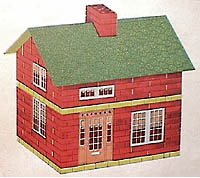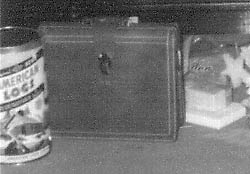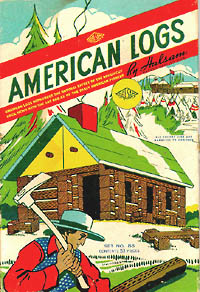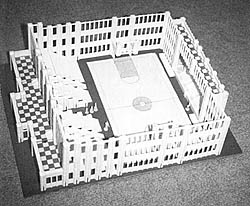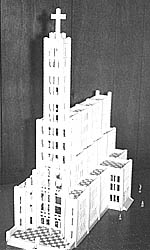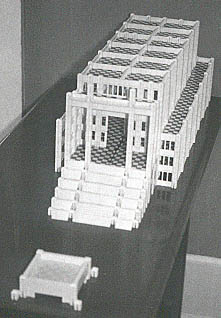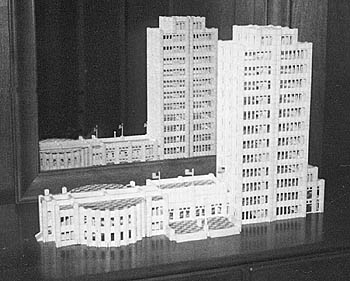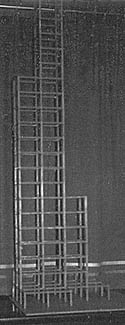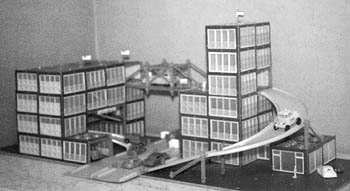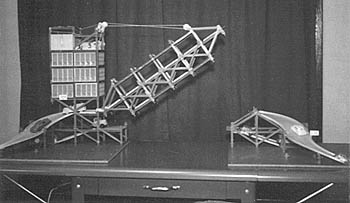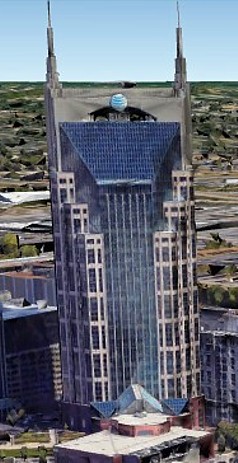![]()
Construction
Toys
Written
November 17, 2002
|
You wouldn't believe how many buildings I built while I was growing up! To be sure, they were model buildings, but I was quite the architect. If you had visited me at home in the early 1960s, you might have seen, in one corner of the dining room, unusual decor like the display of models shown here atop a wheeled metal "typing table." Let me show you some of my pictures.
|
|
I had been playing with construction toys from an early age.
At first, there were simple blocks.
By kindergarten, there was a set of Tinker Toys, a cylindrical container full of dowels and wooden disks. (I recall my father teaching me an important principle when it came time to put the Tinker Toys away: to fit everything into the container, put the largest pieces in first.)
Later, I got an Erector set, a collection of perforated steel pieces that could be assembled with nuts and bolts.
I used the set's electric motor to make a self-propelled toy truck. (It was an impractical vehicle, due to its low-traction smooth aluminum wheels and trailing AC power cord.) I built a Ferris wheel and enlisted my parakeet as a passenger. And when I started announcing high school basketball games into a tape recorder, I used the Erector set to make a collar and chest brace to hold the microphone in front of me.
But I especially enjoyed the toys that were designed to create miniature buildings.
My
parents gave me a set of American Plastic Bricks around the time I
was in first grade. These were stackable plastic blocks, each  of
which was grooved to represent several bricks. Most of the
blocks were red, but white ones could be used for foundations, sills,
and lintels. Wedge-shaped blocks could be used to build
gables. The gables supported a folded green cardboard roof,
embossed with a hexagonal shingle pattern. Holes for doors and
windows could be filled with printed cardboard representations of the
necessary hardware, anchored into slots in the blocks. I spent
hours playing with these pieces in their various combinations,
assembling them into little brick houses and schools.
of
which was grooved to represent several bricks. Most of the
blocks were red, but white ones could be used for foundations, sills,
and lintels. Wedge-shaped blocks could be used to build
gables. The gables supported a folded green cardboard roof,
embossed with a hexagonal shingle pattern. Holes for doors and
windows could be filled with printed cardboard representations of the
necessary hardware, anchored into slots in the blocks. I spent
hours playing with these pieces in their various combinations,
assembling them into little brick houses and schools.
|
|
This picture comes from one of a number of Internet sites that have images of these old building sets and their instruction books. Here are links to some of them.
American
Plastic Bricks, American Logs: |
|
When I was in third grade, we took a photo of the presents under the Christmas tree after they'd been unwrapped. They included a briefcase (to carry my piano music) and a set of American Logs. These rough-textured wooden beams with notched ends were used to construct log cabins. The roof was made of overlapping horizontal green planks, upon which was placed a red wooden block representing the top of a chimney. I took a cabin to school for a display, perhaps for Lincoln's birthday. My parents suggested enhancements. We covered the red wooden block with a layer of brown modeling clay to make it look more realistic, and my father drilled a hole through it, so that "smoke" (from a piece of dry ice hidden in the attic) could actually come out of the chimney. |
|
My
favorite construction kit, because of its versatility, was called
American Skyline. I assembled white plastic drum pieces into
vertical columns, and into the slots between the columns, I slid
horizontal pieces: walls, doors, steps, and so on. There
were also die-cut sheets of plastic printed with a checkerboard
pattern for floors and roofs.
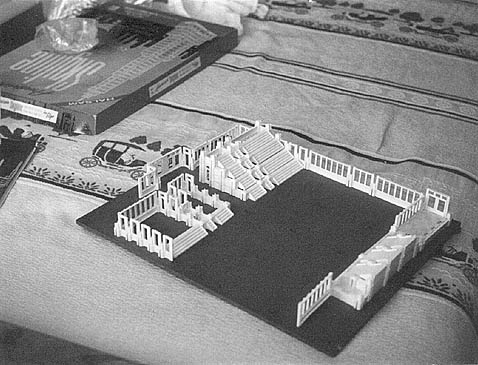
|
|
I based the design above on the Richwood High School gymnasium/auditorium, with permanent seats on one side of the basketball court and a stage with temporary seats on the other side. At the left is the completed (roofless) model, including backboards at each end and a few plastic "people" borrowed from my HO-scale railroad accessories. |
|
When I finished putting a model together, I'd photograph it. I knew that within a week or two I would be taking it apart, to use the pieces for another project. Some designs, like the church on the right, came directly from the book of suggested projects that was included with the construction set. |
|

|
|
I had yet another construction toy, a Girder and Panel building set. Starting from a green Masonite foundation board, red plastic columns and beams formed a skeleton. The skeleton was stiffened either by adding diagonal braces or by snapping on translucent plastic wall panels. The tallest structure that I built with this set was the 21-story skyscraper shown here, without and with its walls. |
|
|
The opaque parts of the wall panels were red or yellow. The flat roof panels were blue, and some had bubble-shaped skylights. The set also included some roadway sections for adding bridges and ramps and such. And a little winch, powered by flashlight batteries, could be used to hoist parts of the structure, such as a double-deck drawbridge (right) or a parking garage with elevator (below). |
|
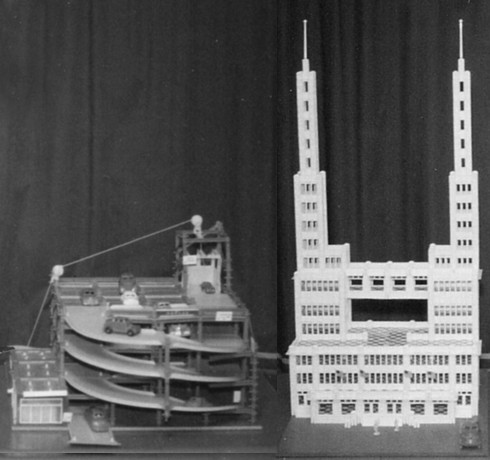
|
The white building with the twin antenna towers was a design from the Skyline project book. It was supposed to represent a broadcasting center, but I'd never seen a double-spired office building. However, some 32 years later South Central Bell opened a 33-story skyscraper in Nashville, Tennessee. Now officially the AT&T Building, the locals call this landmark the Batman Building due to its projecting bat ears.
When I was 40, my father cleaned out the basement by selling much of the junk that had accumulated, including the construction toys that I had long since packed away. But I have these pictures to remind me of them, and I'm grateful for the creativity that they encouraged. |
|

